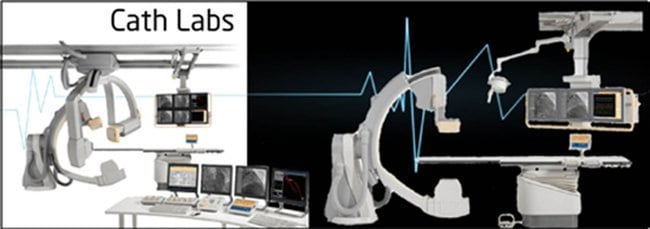Are you ready to add a Cath Lab to your practice, hospital or healthcare facility? Before you do, you’ll need to make some important decisions, like whether or not to use Analog or Digital, or Bi-Plane or Single-Plane. Here are some facts that may help with your decision!
1) The Facts about Analog Systems.
Analog systems use an image intensifier (ii). It is much more durable and less expensive than that of a digital detector.
While the image created by an analog system is very high quality, over time, it will lose image gain, which means the quality of the image will deteriorate. Also, if you have the need to magnify down on an image with an image intensifier, the field of view will become smaller. It’s also important to note that the resolution will never compare to that from a digital system. 
It is also easier to find parts for analog systems than digital ones, since the technology has been around for a lot longer.
An analog system is more affordable, and depending on the needs of your practice, it might be a wise choice.
2) The Facts about Digital Systems.
There are three specific advantages to using a digital system, which uses a flat panel digital detector. Your high quality images will deteriorate over time, but at a much slower pace than analog images. If you have the need to magnify a certain area on a digital system, the field of view will not change. The high quality image created by a digital system also has a higher resolution than provided by an analog system. However, systems with a digital detector are more expensive, since they are newer and include more technological advances. Replacement parts can also be more expensive and tougher to find, since the technology is newer.
3) Should You Choose Single Plane or Bi-Plane?
This is another important consideration when creating your new Cath Lab.
The biggest difference between a Single Plane and a Bi-Plane system is that a Single Plane has one C-Arm (thus one image intensifier or detector) and a Bi-Plane has two C-Arms (thus 2 image intensifiers or detectors). With a Bi-Plane, you can see 3D images in real time using image data captured from two separate C-Arms. Single plane systems can also capture images in 3D, but there will be a delay due to the time it takes for the C-Arm to move, as well as the time it takes the software to reconstruct the image.
It’s no surprise that Bi-Plane systems are more expensive (due to more components), so unless your facility is focusing on heart or brain work, you can probably get by with a Single-Plane system.
Here’s another important consideration about the installation of your Cath Lab: Bi-Plane systems have two C-arms, which means they are much larger. As a result, the room it’s being installed in must be much bigger and the ceiling will need to be able to support a ceiling-mounted C-Arm. And here’s the kicker—a ceiling-mounted C-Arm will add as much as $20K on to the cost of installation!
4) Size of the Image Intensifier
Lastly, there’s the question of which size image intensifier is right for you. There are four different sizes: 9”, 12”, 15” and 16” and the decision should be made based on the procedure the system is being used for. The smaller the image intensifier, the higher degree of magnification that is possible. However, the bigger the image intensifier, the broader the field of view. That being the case, 9” image intensifiers are best suited for cardiac work, while 15” and 16” are better suited for angiography, vascular and neurovascular studies. The 12” image intensifiers are best for facilities that that need to do both cardiac and angio procedures.
Now that you know what to consider when choosing your type of Cath Lab, the next thing is to decide which manufacturer to use and whether used or refurbished systems are a good option for you. Need some assistance? Talk to an expert like Atlantis Worldwide! Contact Us Today!
Some blogs you might have missed:
- Extend The Life of Your Medical Imagining Equipment or Replace It?
- Plan Ahead For Medical Imaging Equipment Purchases
- Free Medical Imaging Resources
- Tweets about Urgent Care Centers
Meet the Author: Alex Silbergleit



